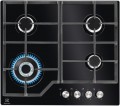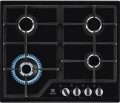—
Enamel. The simplest and most common type of coating. Enamel combines low cost and good strength parameters. In addition, it can be produced in almost any colour. On the other hand, cleaning it can require considerable effort, and over time scratches and chips appear on such a surface.
—
Stainless steel. Steel surfaces have a nice appearance. In addition, they are stronger than enamelled ones; cracks and chips do not appear on them. Also, steel is quite easy to clean, but it is difficult to maintain its cleanliness — dirt appears easily, and even fingerprints can ruin a neat appearance. And for cleaning you need to use special tools, otherwise, you can scratch the stove.
—
Glass ceramics. Glass ceramics as a material is generally remarkable for its high thermal conductivity combined with good strength and heat resistance specs.
Schott Ceram and
EuroKera, manufacturers of this very glass ceramics, which manufacturers of household appliances install in their models, were especially successful in this. It made it possible to create original models of electric hobs, where the heating elements are located under a solid glass ceramic surface. The properties of this material allow it to be used with
induction hobs(see below). Such surfaces do not have protruding part
...s, and the location of the heaters is marked only by lines; thanks to this, you can conveniently move the dishes between the heaters, and cleaning such a surface is as simple as possible. However, there are also disadvantages: glass ceramics is less durable than enamel or steel. It requires dishes with a flat bottom, and spilling liquid on a flat surface is fraught with spreading over the entire stove and (not only). Also, this material is used in gas cooking surfaces "gas-on-glass". However, it is rather fashionable because, in addition to strength, it does not have key advantages over a tempered glass (see below) but costs significantly more.
— Tempered glass. The material used in gas-on-glass cooking hobs. it is used to make a surface over which gas burners are located. Such models have an original appearance, and the glass itself is scratch-resistant and can be cleaned well. Its strength and resistance to heat are much lower than that of glass ceramics (in fact, the latter has become the reason that tempered glass is not used in electric hobs), but these moments are more than offset by low cost.
— Cast iron. An original variant found in some premium gas models. The working surface, in this case, is made of the same cast iron as the burner grates, and the grates themselves are protrusions on the cast iron surface. It gives the entire structure an unusual, very strict appearance. And it increases its reliability: the design of the burner grates is such that they will not bend even under the heaviest dishes. On the other hand, cleaning such a surface can be quite laborious, and this option is not cheap. Because of this, there are only a few models with cast-iron surfaces on the market.
